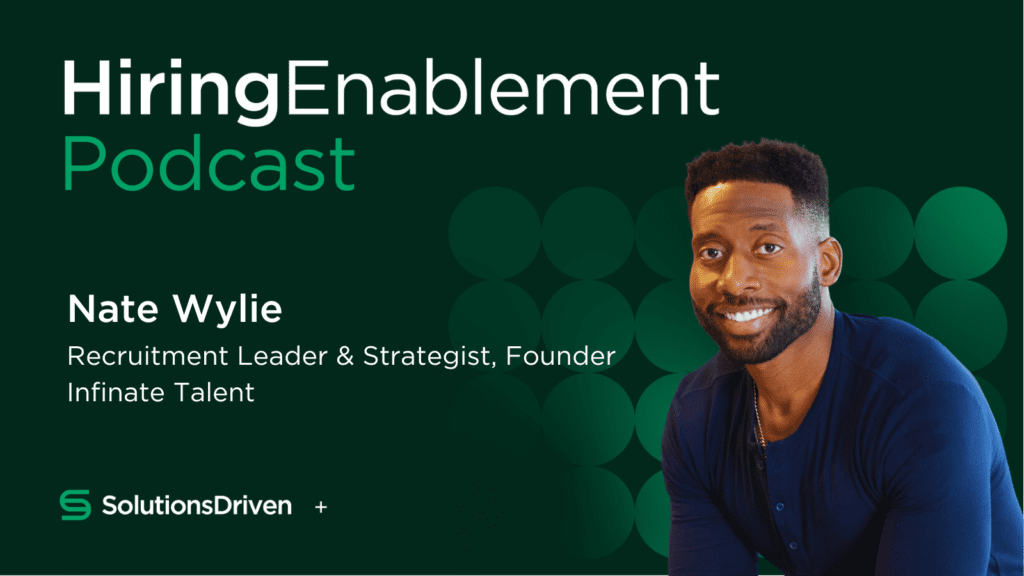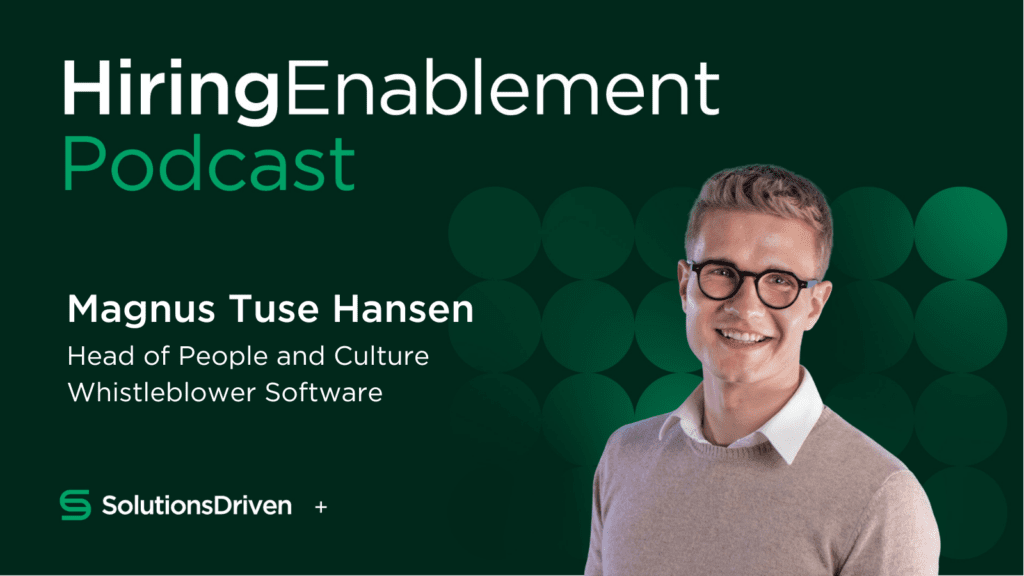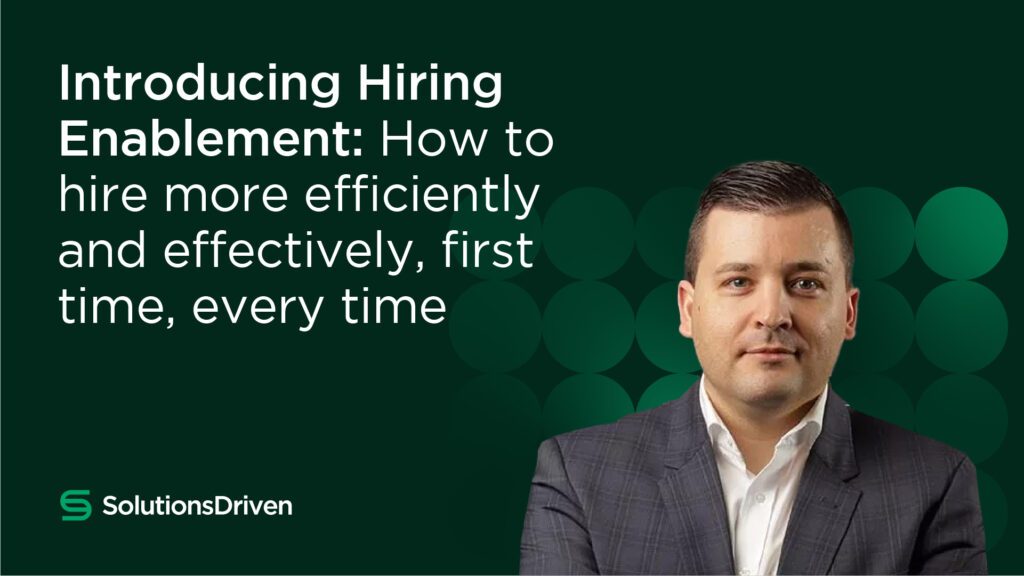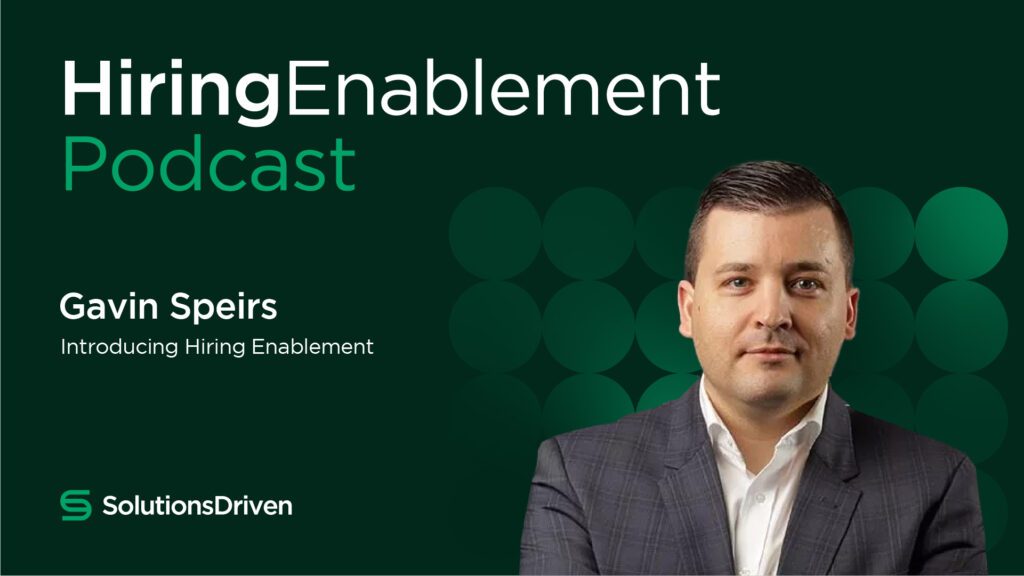In this bonus episode of The Talent Intelligence Podcast, our CEO Gavin Speirs and Head of Marketing Robert Gillespie sit down to explore the key data and intelligence companies should be tracking to measure existing recruitment performance, identify costly leaks and develop future recruitment strategy.
Gavin also shares for the first time via screen share, some of the typical insights and intelligence we gather at Solutions Driven which goes a long way to helping us to guarantee delivery of the right hire, first time and every time for our clients.
Inside this episode we explore:
- The fundamentals of data and intelligence in the recruitment world…and how they can help to drive future recruitment efficiencies including the reduction in hiring costs…
- How to break intelligence and insights down into meaningful buckets so you can quickly and easily track your performance at each stage of the recruitment process and funnel…
- What KPI’s should you be measuring to track effectiveness when it comes to diversity, your brand score, sources of hire, quality of hire and much more…
- How internal goals and strategies should be informing what recruitment metrics you should be tracking…
- And much more…including for the first time, a behind the scenes look at some insights and intelligence we use ourselves here at Solutions Driven to support our 6SProcess…
You can watch the full video, read the transcript or listen to the podcast below. Or if you prefer to listen on your favourite Podcast platform, we’re live on Apple Podcasts, Spotify, Stitcher and Google Podcasts.
Listen to the interview here:
Watch the video interview here:
And here’s the full transcript if you just fancy a good old read through:
Robert (00:14):
Hello, Gavin, how are you?
Gavin (00:14):
Good. Thanks, Robert. You?
Robert (00:17):
Not bad man. In the office, I was going to say, this is the first time I’ve done the podcast in the office, but with the lockdown rules yesterday, it may be the last one in quite a while.
Gavin (00:26):
Could well be, unfortunately.
Robert (00:29):
I’ve even got the hoodie.
Gavin (00:31):
There we go.
Robert (00:32):
I was all suited and booted today as well.
Gavin (00:34):
Branded up.
Robert (00:35):
Branded up. Even got the bottles.
Robert (00:37):
We’ve not had a podcast for a few weeks, but I thought today we’d do one on something that’s asked to me quite a lot. Since we launched Recruitment Process Intelligence, what do we actually mean by data and intelligence and the recruitment process?
Robert (00:51):
So I’m a marketer. For years I have looked at data and intelligence. All those things on Google Analytics, Facebook, and sites, you name it. And I get the point of analytics and insights throughout the process. Whether it’s awareness stage, saturation stage, or closed stage. So can I get to the power of data and intelligence, but from a recruitment point of view. What does that mean to you? What does data intelligence mean to you?
Gavin (01:18):
I think for me, it’s about providing information that is useful to the candidate or client. I think we don’t fall into the trap of just saying “here’s insights, just for the sake of it.” It’s about providing information that prompts a decision, an action, or gives insights that leads a client or candidate to make a better decision.
Gavin (01:36):
I think from my point of view, there’s probably three areas or three times that we use insights and intelligence most. I would say before the recruitment process starts, during the process, and then at the end of the process. And if I talk about before the recruitment process starts, I think as we launched RPI, clearly one of the key elements is intelligence as it’s in the name. And over the last month, we’re starting to really evolve it, offering to tie in as much as possible to that RPI category that we’ve created.
Gavin (02:05):
And I think intelligence, especially in today’s world, is important because people are taking hiring more seriously. They’re looking and saying, “In the current climate, every hire is really important to get the right hire.” Therefore, the insights become more important. I think before the process starts, if we look at ourselves, when we are working on an assignment or a project with a client, one of the key phases that we look at is scoping.
Gavin (02:28):
And within that scoping, we’ve developed tools. All those are really to dig in a bit farther to some insights. An example: let’s say we’re looking at a particular role in the US for example. We can know some clients, things like the location of that talent pool, what the company’s talent pool is working on at the moment, what titles are other organizations calling that particular role, past companies, skills, experience, et cetera.
Gavin (02:57):
We can look at the diversity of the talent pool. And for example, if let’s say we see that the diversity of the pool isn’t what the client is looking for. We can then have that discussion upfront and say, “Okay, rather than looking for X amount of years experience. If you drop that slightly, the talent pool becomes more diverse.”
Gavin (03:14):
So really what we’re trying to do at that front end of the process now is give our clients insights to allow them to start to assess what they’re really looking for. In particular, with diversity being, rightly so, a hot topic right now, it’s not good enough to give those insights at the end of the process. For us, it’s about bringing that up front to really bring that scoping session to life with the client.
Gavin (03:36):
So that’s really almost before the process starts, we’d actually go into quite a bit of detail now, saying, “here’s what you need to know about their kind of the total addressable market.” You could say the talent addressable market. So here is information about the addressable market for the particular hire.
Gavin (03:54):
I think then during the process we talk about insights that we’re giving clients during the process. So we’re looking at things like benchmarking. So what are other organizations paying for this role? Both in terms of salary, bonus benefits, et cetera. And we’re giving clients competitive insights. Saying, we have heard that this organization is doing this relative to this particular role.
And also one of our key parts of our processes is the success. So looking at the factors that are important to candidates, we’re able to give insights during the process that say, “We’re really seeing that for this particular role, freedom is one of the areas that candidates are particularly interested in.” And then also during the process, we’re able to back up that diversity data and say, “Of the long list that we’ve spoke to, 30% of that long list are diverse.” As an example.
Gavin (04:45):
I think then the end point would be after the process. So once the process is concluded, we can almost look at metrics relating to the process, but also just metrics relating to the organizations.
So for example, brand engagement. Of that long list, how many candidates knew of the particular brand? Would engage with the particular brand? What felt good about the particular organization? We can also then look at the traditional metrics, like how long did it take us to fill the role? Time to shortlist, less time to offer. And we do formal quality-of-hire check-ins. One, three, six, and 12 months. How is the candidate? Is our employee at that point matching against what they thought they would do?
Gavin (05:27):
We’re building this data for two reasons. One, to give insights to our customers about the particular role that we’re working on, but two, to leave them with some insights that allows them to kind of think wider and say, “Okay, that’s really interesting. We’ve got an issue in our brand engagement.” Only 30% of the candidates that Solutions Driven contacted actually knew about our organization, as an example.
Robert (05:52):
And I know you wanted to show some examples, which we’ll come to in a minute. Does that kind of data change based on the type of role for example? So if it’s a CEO versus, I don’t know, a head of sales or something like that. Do we still go through the same process or is the data style the same? Or different things? Is it quite flexible?
Gavin (06:12):
It’s flexible. I think there are particular areas more senior searches will focus more on than, let’s say, mid searches. But I guess how we collect that data is the same process, but we can bespoke that to the customer need. If a customer says, “In this particular role, someone has to have had five years experience with the current role. I don’t want a job hopper.” I want credibility, et cetera, et cetera. That’s something that we can build into the front end of the scoping and the insights.
Robert (06:41):
Great. So, what are you showing?
Robert (06:48):
For those listening in, you just need to try and grab a copy of the video. We’ll put that on the website, but we’re going to be looking at just data on a spreadsheet. Just to show the types of intelligence we were talking about there.
Gavin (06:59):
So you can take this as an example. What we’ve done here is just a complete example, a VP of sales based in the US. Has to have experience of working in SaaS, and has to come from a pharma or life science background from a sector experience point of view.
Gavin (07:15):
What you can see here is just how we consolidate data. we can see that there are circa 160 candidates that match that particular requirement. And we can then look at where those candidates are based across the US and really understand what hot spots of where we should be targeting that talent.
We can then look and understand, where are those candidates coming from in terms of current organizations? What are they called? Because if it’s a VP of sales, it could be called a variety of different things.
Gavin (07:45):
And again, it shows you some examples there. And all this is doing is helping our team really make sure that we are addressing the total available market. We’re looking at past companies. So are there any links to where they’ve worked before? And understanding some, connections there. Past titles, we can look at years of experience and roles. So we can see that the majority of this talent pool are fairly experienced and have more than 10 years, which you would expect the level of a VP.
Gavin (08:13):
We can then look at tenure in role. So we can see quite a big part of this talent pool have actually recently moved. So again, what will make them more likely to move? Just know, what’s the kind of candidate value proposition that’s going to attract people that are already only in the current role two years? We can look at things like education background, so we can see what percentage of that talent pool have degrees, MBAs, et cetera? What did they major in?
Gavin (08:39):
So what are their functional subjects that this talent pool are most experienced in? We can look at diversity and say, “19% of the pool are female. 1% African-American, et cetera.” And again, why do we do this? Because I want a client up front to say, “Okay, so if we really want to make sure that this is a diverse short list, we actually are comfortable with people with less than X amount of years and current role, et cetera.”
Gavin (09:06):
And then we can start looking at industry. So what industries will these people typically come from? And as you would expect, given that this particular one is SaaS and pharma, obviously the top ones, there are SaaS, healthcare, pharmaceutical, et cetera.
Gavin (09:19):
And then lastly, we can look at the size of company so we can see quite a big percentage of this talent pool are in smaller organizations. Maybe all startups, highly growing organizations. Again, the question is, what will entice them out of an organization that may be growing fairly quickly?
Gavin (09:39):
We can look at things like, what groups are people in this talent pool typically involved in? Because that gives their team an understanding to say, “Okay, here’s the areas we need to really get further understanding.” And so that’s really just an example of some of the data that we’re using ahead of a recruitment process starting.
Gavin (10:02):
And really, this data then gives our clients confidence that A, we can understand how we map a market. B, it’s about giving them insights. It’s about having those discussions around, you’ll see here quite a big part of the talent pool have recently moved, and they’re all for less than two years. Is that an issue? Because we’ve got some clients that say, “We want someone who’s showing progress and has been steady, and has been in the same role for five years.”
Gavin (10:27):
Whereas we can demonstrate there that quite a big part of that talent pool hasn’t as an example. So it’s really about opening up that discussion, which allows us to scope that all correctly.
Robert (10:37):
So that gets used just for reference data at the beginning of a process?
Gavin (10:40):
Yes. And it’s fairly new. I mean, we’ve literally just started embedding this into our process over the last few weeks. We used to do this more kind of indirectly through the process and as part of what we’ve done or what we do. But now we’re bringing this front and center to the start of the process. So our team and the hiring team really just get a better understanding of what candidate availability is there?
Robert (11:05):
And what’s the feedback been like so far? It’s the first time I’ve seen it. It looks great.
Gavin (11:09):
Yeah, it’s been good. I think a few clients have said, “we’re impressed with the level of detail that you go into. We’re impressed with how serious you take this mapping out talent.” I think too many recruiters can sometimes say things like, “This is a tough space. There’s not many candidates available for this role.” And for us, going back to the word intelligence, we’re trying to provide that intelligence behind it, that we can back things up by data.
Gavin (11:35):
And also, more and more of our clients are not expecting this kind of thing. I think the majority of our clients are multinational organizations, use data every day. Therefore, when partnering with external organizations, they almost have an expectation of how this kind of thing should work.
Robert (11:51):
It actually leads me nicely to my next question. Because there was an article by a gentleman, Bernard Mar. And he was coming at it from a clients or a company’s perspective. He was talking about how the metrics should come from the company’s goals, whatever their goals are.
Robert (12:15):
So for example, if their company goal, as you just said, was to increase its talent pool in terms of diversity, or maybe just reduce costs. I can imagine that level of data, even one of the slides you showed me there about the candidate pool, that must become, or should become the norm?
Gavin (12:40):
I don’t think it’s yet becoming the norm. I think it should be the norm. I think one of our challenges that we’re trying to educate clients with is some clients have buzzwords in mind. Diversity, et cetera. And some things are talked about too late in the process when the long list is engaged and the short list has been screened. What we’re trying to do up front is show what is important to you is your start point, with the end goal in mind.
Gavin (13:08):
So if the organization wants to increase employer brand or brand awareness, the organization wants to increase the diversity of the talent pool. What can we as an external partner talk about upfront to really understand what we then need to do to build that into our process?
Gavin (13:24):
And I think that’s the base way it works. I think, when it’s taught at the end retrospectively, it’s more difficult to end pipe. Hence why we are trying to bring intelligence to the start of the process.
Robert (13:35):
I’m trying to think ahead, post hire. So for example, once the hiring’s finished we do check-in calls. What kind of things do we look at at that stage then?
Gavin (13:49):
There’s almost two levels of it. I think as you know, I obviously focused quite heavily a few years ago in quality of hire. And looked at, how do we build a platform that starts to measure that? I think two things, you can only really measure quality of hire if you are measuring against something. I think it’s too subjective to say Gavin isn’t a good fit, six months later. Why and where are the gaps?
Gavin (14:10):
So what we are doing is really formal reviews with clients one, three, six, and 12 months. To say, how is the employee that’s now joined performing? But we’re also taking information from that and building that into future hires. So for example, if an organization says, “Yep, they’re doing well, but we really need more kind of strategic commercial thinking.” We’re then taking that and saying, “Okay, the next time we recruit, we will remember that. And will then build that into the front-end scoping that we talk about.”
Gavin (14:40):
So it’s allowing the client to not have to keep saying that to us because we are taking that data. And I think then, from an ongoing quality of hire, there’s the objective and subjective. So we’re looking at NPS score, how satisfied are customers with our process, but also how long do our talent stay? And we track some metrics just around three things, the diversity of candidates that we’ve placed, the tenure of candidates that we’ve placed. And also how many as a percentage get promoted in the first couple of years, when they join the organization.
Robert (15:17):
And do we look at things like the source of hire? Do you look at that post hire? For example, did they come from LinkedIn or other sources and quality?
Gavin (15:28):
Yeah. I’ll go on my soap box here. But I think too many people just look at source of hire and don’t actually look at the quality of the source. So I think the key is matching that up.
Gavin (15:41):
So for example, you could have an organization that say our best source is LinkedIn, because we hired a hundred people on LinkedIn. But what they don’t see is, and out of those hundred people, X were leavers, X were bad hires, et cetera. So for us, it’s about not only measuring the source, which we do. But it’s also measuring the quality of that source linked to, how many of those hires stay? How many of those hires are promoted in the organization?
Robert (16:05):
Right. AI seems to crop up in every single conversation. I’ve just read here how AI as a tool can boost recruitment effectiveness. And the article was talking about how AI is getting better, understanding humans, whether it’s personality, traits, likes, maybe some of the data you shared with us. Maybe over time it interrogates that data, takes it to a deeper level.
Robert (16:37):
How do you think AI will help in terms of recruitment effectiveness? Also all these metrics and insights that we’re providing. Will it do a lot of the legwork for us in terms of providing insights?
Gavin (17:01):
My view is, and we talked about this a couple of weeks ago in the last one. There’s a blend of art and science in recruitment. And for me, the science is our own. How do we automate sourcing? How do we get AI used in the process and how do we learn from what we’re doing?
And then the art pieces, how do we engage candidates? How do we provide insightful information to the customer to the point of the time? So I think there’s still quite a big gap. And for the recruiter, which is knowing your customer and knowing what data is important to your customer at the point in time. Yeah, you may pull that data from an AI source or whatever, but I think the human still has to think about what’s important to the customer.
Gavin (17:40):
I think going into AI, there’s probably three obvious benefits. There’s clearly, the time, the quality and the cost. And I think if you look at it, we’re using tools now that have AI built into them. That’s allowing our recruiters to front end, spend time on that sourcing, that insight, that mapping out the market.
Gavin (17:58):
We’ve got options now that allows us to do almost blind sourcing. So to remove bias, you can say rather than looking at a talent pool and being biased, we can now look at a talent pool blind, that allows us to prevent any bias, as an example. I think where the AI impacts, is the learning element of it.
Gavin (18:20):
So it’s clear, even in the tools that we use, AI isn’t perfect, so it needs fed. It needs to learn, it needs to improve, but it definitely will.
Gavin (18:30):
And then obviously over time, that should be a cost saving. Rather than continuing to hire lots of recruiters, we are looking at what parts of the process can we automate and ultimately be more efficient. Anyone that says AI doesn’t exist in recruitment is, for me, not thinking correctly, but there’s a blend of the science and the art.
Robert (18:53):
One hundred percent. And the presentation was very good. I’ve not seen that before. So appreciate that. I’ll let you go and we’ll catch up very soon.
Gavin (19:03):
Brilliant. Thanks for your time.
Robert (19:06):
Take care.
Gavin (19:06):
Bye bye.
Robert (19:06):
Bye.





